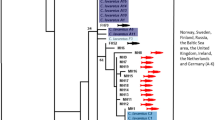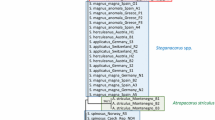Abstract
The present study was aimed to get the nucleotide sequences of a part of COII mitochondrial gene amplified from individuals of five species of Termites (Isoptera: Termitidae: Macrotermitinae). Four of them belonged to the genus Odontotermes (O. obesus, O. horni, O. bhagwatii and Odontotermes sp.) and one to Microtermes (M. obesi). Partial COII gene fragments were amplified by using specific primers. The sequences so obtained were characterized to calculate the frequencies of each nucleotide bases and a high A + T content was observed. The interspecific pairwise sequence divergence in Odontotermes species ranged from 6.5% to 17.1% across COII fragment. M. obesi sequence diversity ranged from 2.5 with Odontotermes sp. to 19.0% with O. bhagwatii. Phylogenetic trees drawn on the basis of distance neighbour-joining method revealed three main clades clustering all the individuals according to their genera and families.



Similar content being viewed by others
References
Roderick GK (1996) Geographic structure of insect populations: gene flow, phylogeography, and their uses. Annu Rev Entomol 41:325–352
Caterino MS, Cho S, Sperling FAH (2000) The current state of insect molecular systematics: a thriving tower of Babel. Annu Rev Entomol 45:1–54
Xiang B, Kochar TD (1991) Comparison of mitochondrial DNA sequences of seven morphospecies of black flies (Diptera). Genome 34:306–311
Fang Q, Black WCIV, Blocker HD, Whitcomb RF (1993) A phylogeny of New World Delta cephalus like leafhopper genera based on mitochondrial 16S ribosomal DNA sequences. Mol Phylogenet Evol 2:119–131
Kambhampati S (1995) A phylogeny of cockroaches and related insects based on DNA sequence of mitochondrial ribosomal RNA genes. Proc Natl Acad Sci USA 92:2017–2020
Tang J, Pruess K, Cupp EW, Unnasch TR (1996) Molecular phylogeny and typing of blackflies (Diptera: Simuliidae) that serve as vectors of human or bovine onchocerciasis. Med Vet Entomol 10:228–234
Mindell DP, Sorenson MD, Dimcheff DE, Hasegawa M, Ast JC, Yuri T (1999) Interordinal relationships of birds and other reptiles based on whole mitochondrial genomes. Syst Biol 48:138–152
Waddell PJ, Cao Y, Hasegawa M, Mindell DP (1999) Assessing the cretaceous superordinal divergence times within birds and placental mammals using whole mitochondrial protein sequences and an extended statistical framework. Syst Biol 48:119–137
Castresana J (2000) Selection of conserved blocks from multiple alignments for their use in phylogenetic analysis. Mol Biol Evol 17:540–552
Hwang UW, Park CJ, Yong TS, Kim W (2001) One step PCR amplification of complete arthropod mitochondrial genomes. Mol Phylogenet Evol 19:345–352
Boore JL, Brown WM (1998) Gene translocation links insects and crustaceans. Nature 392:667–668
Curole JP, Kocher TD (1999) Mitogenomics: digging deeper with complete mitochondrial genomes. Trends Ecol Evol 14:394–398
Kambhampati S, Kjer KM, Thorne BL (1996) Phylogenetic relationship among termite families based on DNA sequence of mitochondrial 16S ribosomal RNA gene. Insect Mol Biol 5:229–238
Jenkins TM, Dean RE, Verkerk R, Forschler BT (2001) Phylogenetic analysis of two mitochondrial genes and one nuclear intron region illuminate European subterranean termite (Isoptera: Rhinotermitidae) gene flow, taxonomy and introduction dynamics. Mol Phylogenet Evol 20:286–293
Austin JW, Szalanski AL, Uva P, Bagnere's AG, Kence A (2002) A comparative genetic analysis of the subterranean termite genus Reticulitermes (Isoptera: Rhinotermitidae). Ann Entomol Soc Am 95:753–760
Crozier RH, Crozier YC, Mackinlay AG (1989) The COI and the COII region of honeybee mitochondrial DNA: evidence for variation in insect mitochondrial evolutionary rates. Mol Biol Evol 6:399–411
Liu H, Beckenbach AT (1992) Evolution of the mitochondrial cytochrome oxidase II gene among 10 orders of insects. Mol Phylogenet Evol 1:41–52
Jermiin LS, Crozier RH (1994) The cytochrome b region in the mitochondrial DNA of the ant Tetraponera rufoniger: sequence divergence in Hymenoptera may be associated with nucleotide content. J Mol Evol 38:282–294
Miura T, Maekawa K, Kitade O, Abe T (1998) Phylogenetic relationships among subfamilies in higher termites (Isoptera: Termitidae) based on mitochondrial COII gene sequences. Ann Entomol Soc Am 91:515–523
Jenkins TM, Basten CJ, Kresovich S, Forschler BT (1999) Mitochondrial gene sequence questions Reticulitermes species social structure (Isoptera: Rhinotermitidae). Sociobiology 34:161–172
Lo N, Tokuda G, Watanabe H, Rose H, Slaytor M, Maekawa K, Bandi C, Noda H (2000) Evidence from multiple gene sequences indicates that termites evolved from wood-feeding cockroaches. Curr Biol 10(13):801–804
Austin JW, Szalanski AL, Gold RE, Foster BT (2004) Genetic variation and geographical distribution of the subterranean termite genus Reticulitermes in Texas. Ann Entomol Soc Am 97:575–582
Sambrook J, Fritsh EF, Maniatis T (1989) Molecular cloning: a laboratory manual. Cold Spring Harbour Laboratory Press, New York
Ballard JWO (1999) Mitochondrion mitochondrion Drosophila mauritiana (fruitfly). Direct submission (NC_005779)
Altschul SF, Madden TL, Schäffer AA, Zhang J, Zhang Z, Miller W, Lipman DJ (1997) Gapped BLAST and PSI-BLAST: a new generation of protein database search programs. Nucleic Acids Res 25:3389–3402
Thompson JD, Higgins DG, Gibson TJ (1994) CLUSTAL W, improving the sensitivity of progressive multiples sequence alignments through sequence weighting, position-specific gap penalties and weight matrix choice. Nucleic Acids Res 22:4673–4680
Katoh H, Miura T, Maekawa K, Shinzato N, Matsumoto T (2002) Genetic variation of symbiotic fungi cultivated by the macrotermitinae termite Odontotermes formosanus (Isoptera: Termitidae) in Ryukyu Archipelago. Mol Ecol 11:1565–1572
Yashiro T, Matsuura K (2007) Distribution and phylogenetic analysis of the termites egg mimicking fungi ‘termite balls’ in Reticulitermes termites. Ann Entomol Soc Am 100:532–538
Avise JC, Arnold J, Ball RM, Bermingham E, Lamb T, Neigel JE, Reeb CA, Saunders NC (1987) Intraspecific phylogeography: the mitochondrial DNA bridge between population genetics and systematics. Annu Rev Ecol Syst 18:489–522
Avise JC (1998) The history and purview of phylogeography: concepts a personal reflection. Mol Ecol 7:371–379
Szalanski AL, Austin JW, Owens CB (2003) Identification of Reticulitermes spp. (Isoptera: Rhinotermitidae) by polymerase chain reaction-restriction fragment length polymorphism. J Econ Entomol 96(5):1514–1519
Austin JW, Szalanski AL, Scheffrahn RH, Messenger MT (2005) Genetic variation of Reticulitermes flavipes (Isoptera: Rhinotermitidae) in North America using the mitochondrial rRNA 16S gene. Ann Entomol Soc Am 98:980–988
Foster BT, Cognato AI, Gold RE (2004) DNA based identification of the eastern subterranean termite, Reticulitermes flavipes (Isoptera: Rhinotermitidae). J Econ Entomol 97:95–101
Kaib M, Franke S, Francke W, Brandl R (2002) Cuticular hydrocarbons in a termite: phenotypes and a neighbor-stranger effect. Physiol Entomol 27:189–198
Liang D, Silverman J (2000) ‘You are what you eat’: diet modifies cuticular hydrocarbons and nestmate recognition in the Argentine ant, Linepithema humile. Naturwissenschaften 87:412–416
Florane CB, Bland JM, Husseneder C, Raina AK (2004) Diet-mediated inter-colonial aggression in the formosan subterranean termite Coptotermes formosanus. J Chem Ecol 30(12):2559–2574
Olsen GJ, Woese CR (1993) Ribosomal RNA: a key to phylogeny. FASEB J 7:113–123
Miura T, Roisin Y, Matusmoto T (2000) Molecular phylogeny and biogeography of the nasute termite genus Nasutitermes (Isoptera: Termitidae) in the Pacific tropics. Mol Phylogenet Evol 17:1–10
Thompson GJ, Miller LR, Lenz M, Crozier RH (2000) Phylogenetic analysis and trait evolution in Australian lineages of drywood termites (Isoptera: Kalotermitidae). Mol Phylogenet Evol 17:419–429
Althoff DM, Thompson JN (2001) Geographic structure in the behavioural approaches. J Evol Biol 14:406–417
Hufbauer RA, Bogdanowicz SM, Perez L, Harrison RG (2001) Isolation and characterization of microsatellites in Aphidius ervi (Hymenoptera: Braconidae) and their applicability to related species. Mol Eco Notes 1:197–199
De La Rua P, Galian J, Serrano J, Moritz RFA (2001) Molecular characterization and population structure of the honeybees from the Balearic Islands (Spain). Apidologie 32:417–427
Estoup A, Solignac M, Cornuet JM, Goudet J, Scholl A (1996) Genetic differentiation of continental and Island populations of Bombus terrestris (Hymenoptera: Apidae) in Europe. Mol Ecol 5:19–31
Widmer A, Schmid-Hempel P, Estoup A, Scholl A (1998) Population genetic structure and colonization history of Bombus terrestris (Hymenoptera: Apidae) from the Canary Islands and Madeira. Heredity 81:563–572
Althoff DM, Groman JD, Segraves KA, Pellmyr O (2001) Phylogeographic structure in the bogus yucca moth Prodoxus quinquepunctellus (Prodoxidae): comparisons with coexisting pollinator yucca moths. Mol Phylogenet Evol 21(1):117–127
Brown B, Emberson RM, Paterson AM (1999) Mitochondrial COI and COII provide useful markers for Wiseana (Lepidoptera: Hepialidae) species identification. Bull Entomol Res 89:287–293
Edward L, Vargo EL, Husseneder C (2009) Biology of subterranean termites: insights from molecular studies of Reticulitermes and Coptotermes. Annu Rev Entomol 54:379–403
Uva P, Clement J, Austin JW, Zaffagnini V, Quintana A, Bagneres AG (2003) Origin of a new Reticulitermes termite (Isoptera: Rhinotermitidae) inferred from mitochondrial DNA data. Mol Phylogenet Evol 30:344–353
Acknowledgements
We acknowledge Council of Scientific and Industrial research (CSIR), New Delhi, for financial support and Zoological Survey of India (ZSI), Kolkata, for species identification.
Author information
Authors and Affiliations
Corresponding author
Rights and permissions
About this article
Cite this article
Sobti, R.C., Kumari, M., Sharma, V.L. et al. Sequence analysis of a few species of termites (Order: Isoptera) on the basis of partial characterization of COII gene. Mol Cell Biochem 331, 145–151 (2009). https://doi.org/10.1007/s11010-009-0152-z
Received:
Accepted:
Published:
Issue Date:
DOI: https://doi.org/10.1007/s11010-009-0152-z




